Creating and Configuring Redundancy Supplemental Feature
Scenario: You want to configure the Redundancy Supplemental feature.
Reference: For background information, see the reference section.
Workflow diagram:
Steps:
After completing the installation of the everRun software, log on to the everRun Availability Console to accept the end-user license agreement (EULA) and to manage the everRun system.
- To log on to the everRun Availability Console the first time, you need the following:
a) The node0 (primary) IP address - You note this address during installation.
See the Recording the Management IP Address section of the everRun’s User’s Guide.
b) The system IP address - The network administrator provides this information.
See the Obtaining System IP Information section of the everRun’s User’s Guide.
c) The license .KEY file that you received from Stratus when you purchased the everRun software - You must upload this file to the everRun Availability Console to complete the initial logon. Locate the file before you begin the initial logon.
- From the remote management computer, enter the IP address of node0 (primary) into a browser address bar.
- The logon page of the everRun Availability Console displays.
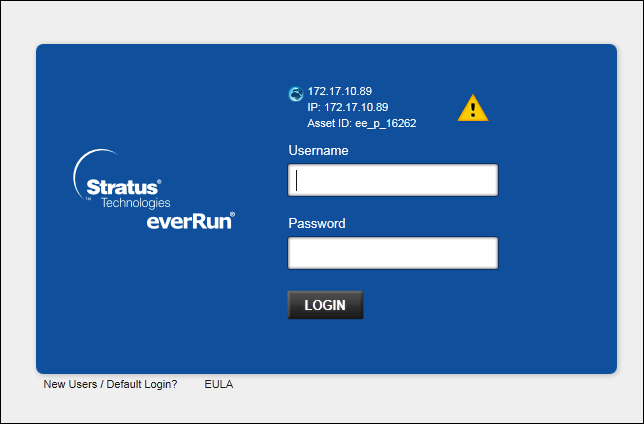
- Enter admin for the Username and admin for Password, and then click LOGIN.
- The Stratus everRun EULA displays.
- Read the EULA and click Accept.
- The INITIAL CONFIGURATION page displays.
- Select NOTIFICATIONS.
- The Enable Support Notifications check box is checked, by default. If you do not want the everRun system to send health and status notifications to your authorized Stratus service representative, uncheck the box. You can change this setting later.
See the Configuring Remote Support Settings section of the everRun’s User’s Guide.
- Select SYSTEM IP.
- For IP Address, enter the address you obtained from your network administrator.
- Enter the network information.
- Click Continue.
- The Portal Restart Required window displays.
- After a minute, click OK.
- The LICENSE INFORMATION window displays.
- Select Upload License Key.
- Click Browse and select the license .KEY file that you received from Stratus.
- Select the license file and click Upload.
- The initial logon is complete, and the everRun Availability Console displays.
- Bookmark or otherwise make note of the system IP address for use when logging in to the console in the future.
NOTE: For security, change the default user login name and password for the admin account on the Users & Groups page.
See the Managing Local User Accounts section of the everRun’s User’s Guide. The DASHBOARD of the everRun Availability Console displays node0.
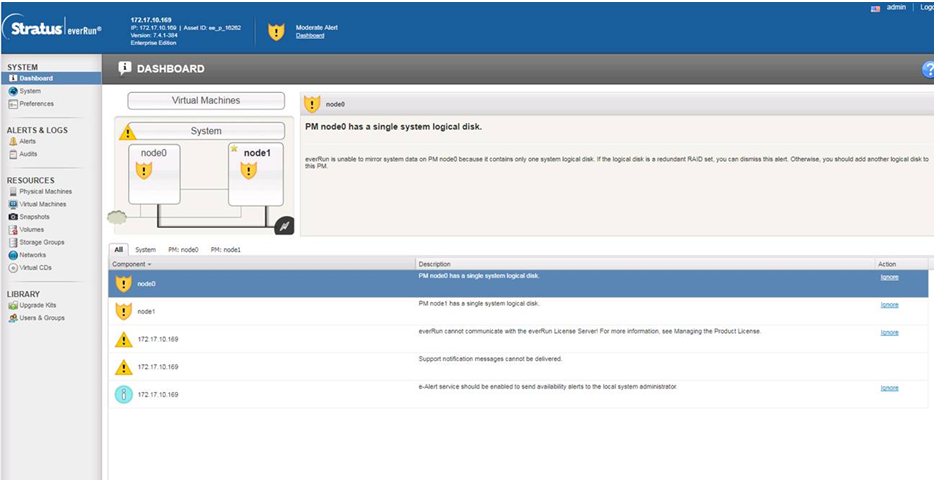
To create a VCD, use the Virtual CD Creation Wizard to copy an ISO file to a storage device on the everRun system. Thereafter, you can boot from it.
See the Booting from a Virtual CD section of the everRun’s User’s Guide to install a guest operating system or start a VM from a bootable recovery VCD.
NOTE 1: You cannot use VCDs to install applications in virtual machine. If necessary, mount a network drive or ISO image in the guest operating system to access application media.
NOTE 2: Each VCD consumes disk space in the storage group in which it is stored. Unless you use a VCD on a regular basis, remove it when it is no longer needed.
NOTE 3: If you create a bootable VCD for installation, it must be a single CD or DVD. Multiple CDs or DVDs are not supported.
- If necessary, create ISO files of any physical media for which you will create VCDs.
- Open the Virtual CDs page in the everRun Availability Console.
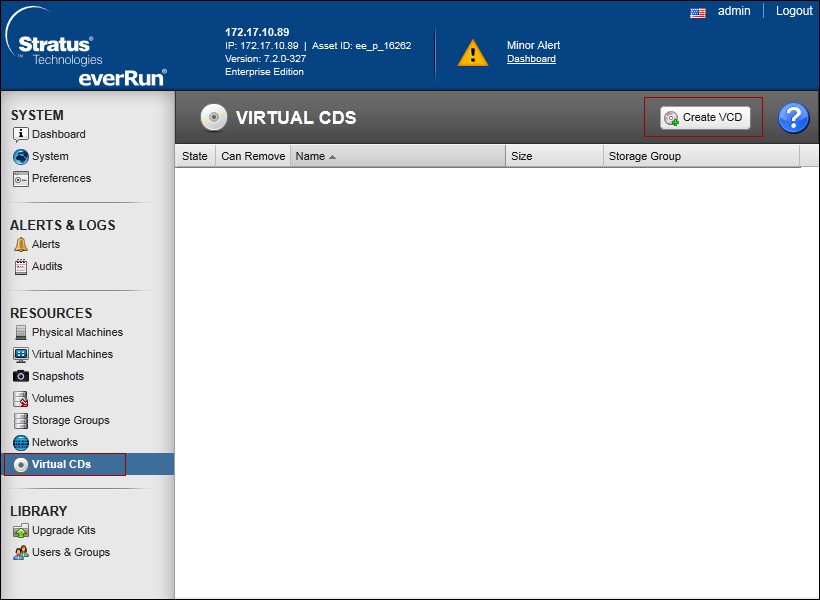
- Click Create VCD.
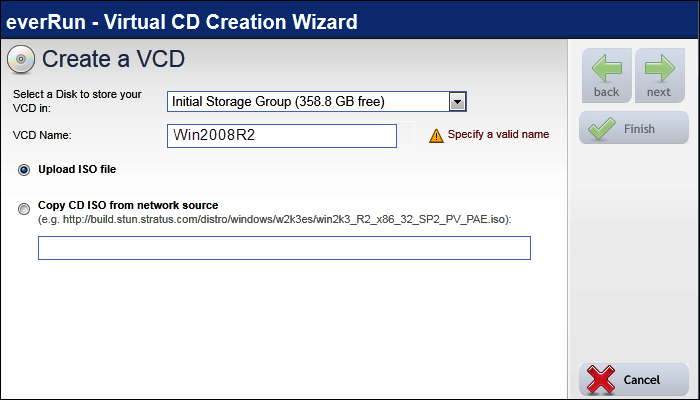
- In the Virtual CD Creation Wizard window, select a storage group with sufficient free space for the VCD.
- Enter a name for the VCD.
- Select a source for the VCD from the following options:
- Upload ISO file uploads a file from your remote system running the everRun Availability Console.
- Copy CD ISO from network source copies the file from a web URL.
- If you selected Upload ISO file, click Next and select the ISO file to upload.
- Click Finish to upload or copy the ISO file from the specified source.
- The Virtual CD Creation Wizard reports that the VCD has been successfully added, but transferring the image may take several more minutes depending on the size of the image. You can determine the status of a VCD by checking the State column on the Virtual CDs page:
a) A syncing icon indicates that the VCD is still being created.
indicates that the VCD is still being created.
b) A broken icon indicates that the VCD creation failed. Remove the VCD and try creating it again.
indicates that the VCD creation failed. Remove the VCD and try creating it again.
c) A normal icon indicates that the transfer is complete and that the VCD is ready to use.
indicates that the transfer is complete and that the VCD is ready to use.
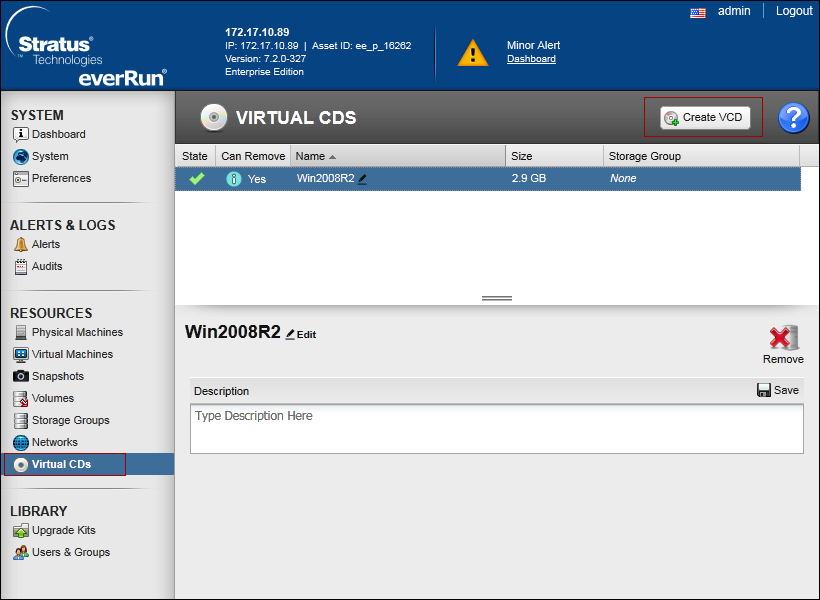
This section lists the steps required to create a new virtual machine (VM) to install a guest operating system on your everRun system.
NOTE: If you need to create a Windows Server 2003 VM, see the Creating a New Windows Server 2003 Virtual Machine section of the everRun’s User’s Guide.
You must perform a different procedure to create a Windows Server 2003 VM.
- Review the prerequisites and considerations for allocating CPUs, memory, storage, and network resources to the VM, as listed in Planning Virtual Machine Resources.
- Create a bootable virtual CD (VCD) of the Windows or Linux installation media, as described in Creating a Virtual CD. The bootable VCD must be a single CD or DVD. Multiple CDs or DVDs are not supported.
- Ensure that both PMs of the everRun system are online; otherwise, the system cannot properly create the VM.
- If you want to protect the new VM with Disaster Recovery (DR), wait until after you finish installing the guest operating system. If necessary, open the VM console and verify that the guest is healthy and responsive before enabling DR protection in the One View Console. While setting up protected VM , assign minimum 10 Cores to VM.
- Do not install any extra applications on VM. It may affect performance of MNS.
- Do not keep SMC or Desigo CC User Interface in open state on VM. It may affect performance of MNS.
- On the Physical Machines page, verify that both PMs are in the running state and that neither PM is in maintenance mode or in the process of synchronizing.
See The Physical Machines Page section of the everRun’s User’s Guide.
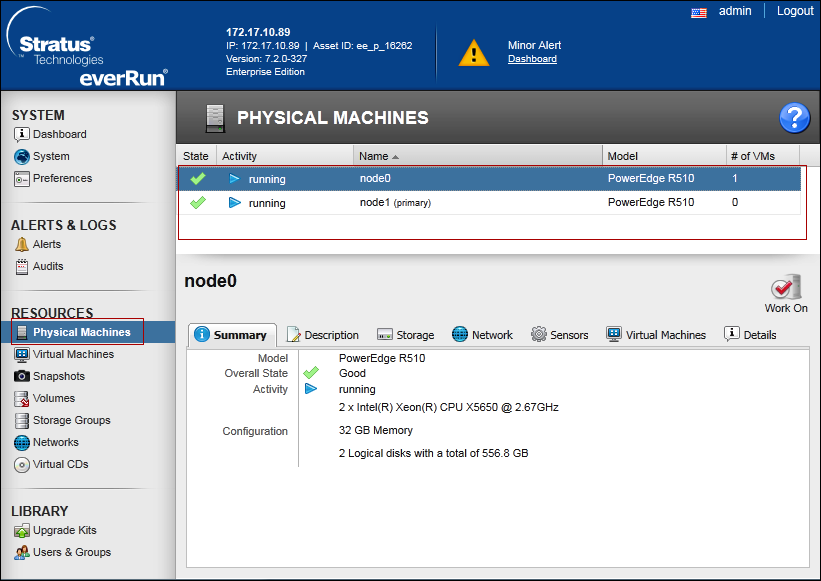
- On the Virtual Machines page, click Create to open the VM Creation Wizard.
See The Virtual Machines Page section of the everRun’s User’s Guide.
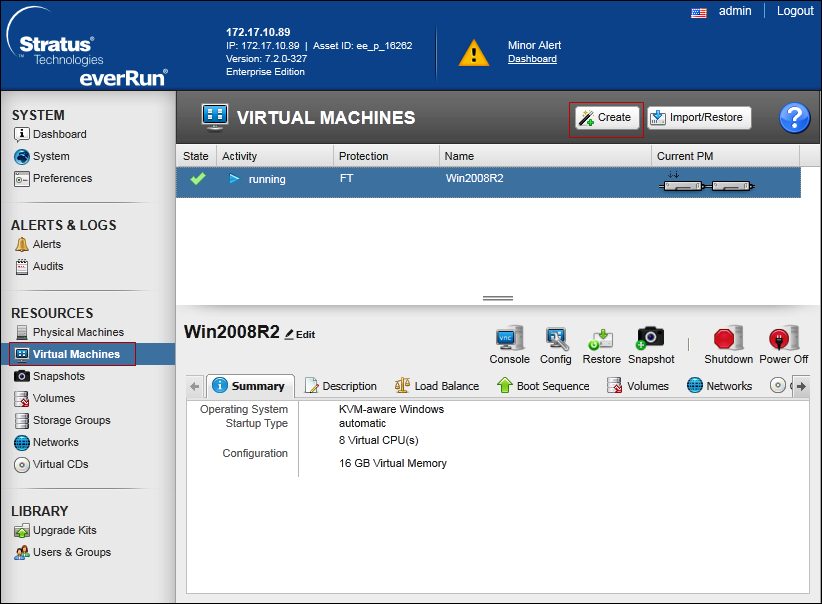
- On the Name, Description, Protection and OS page:
- Enter the name and an optional description for the VM as they will display in the everRun Availability Console.
- Select the level of protection to use for the VM:
a) High Availability (HA) - Provides basic failover and recovery, with some faults requiring an (automatic) VM reboot for recovery. Use HA for applications that can tolerate some downtime and that do not need the downtime protection that FT provides.
b) Fault Tolerant (FT) - Transparently protects an application by creating a redundant environment for a VM running across two physical machines. Use FT for applications that need greater downtime protection than HA provides.
NOTE: For more information about these levels of protection, see the Modes of Operation section of the everRun’s User’s Guide.
Select the Boot VCD that contains the operating system you want to install.
- Click Next.
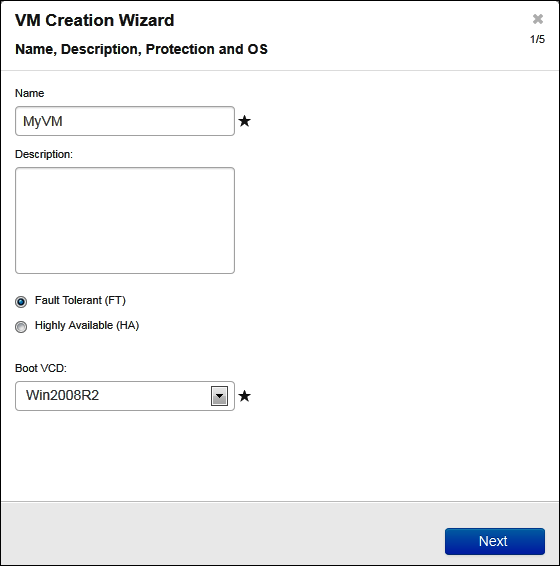
- On the vCPUs and Memory page, enter the number of vCPUs and the amount of Memory to assign to the VM. For more information, see Planning Virtual Machine vCPUs and Planning Virtual Machine Memory. To continue, click Next.
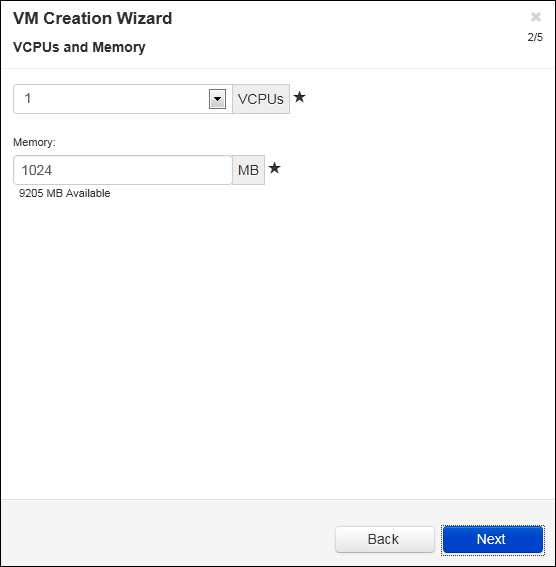
- On the Volumes page, do the following:
- Enter the Name of the boot volume as it will display in the everRun Availability Console.
- Enter the Container Size and Volume Size of the volume to create in gigabytes (GB). The container size is the total size for the volume including extra space to store snapshots. The volume size is the portion of the container that is available to the guest operating system. For more information about allocating storage, see Sizing Volume Containers and Planning Virtual Machine Storage.
- Select the Disk Image format:
a) RAW - raw disk format
b) QCOW2 - QEMU Copy On Write (QCOW2) format, which supports snapshots and Disaster Recovery
- Select the Storage Group in which to create the volume.
- If applicable, create additional data volumes by clicking Add New Volume and specifying the parameters for each volume. (You can also add volumes after you create the VM by using the Reprovision Virtual Machine wizard, as described in Creating a Volume in a Virtual Machine.)
- Click Next.
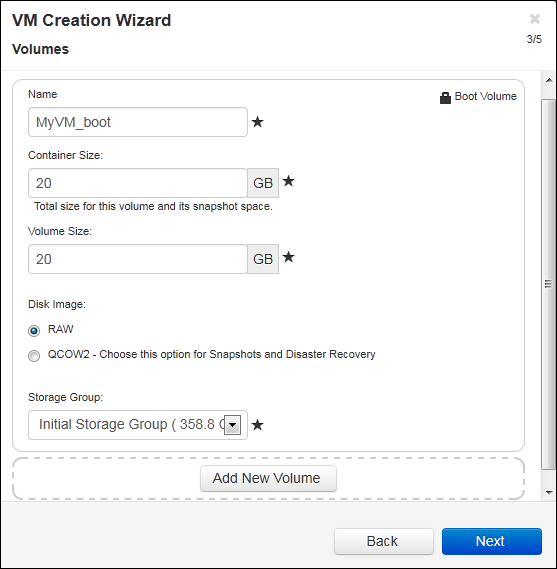
- On the Networks page, select the shared networks to attach to the VM. For more information, see the Planning Virtual Machine Networks section of the everRun’s User’s Guide. Click Next.
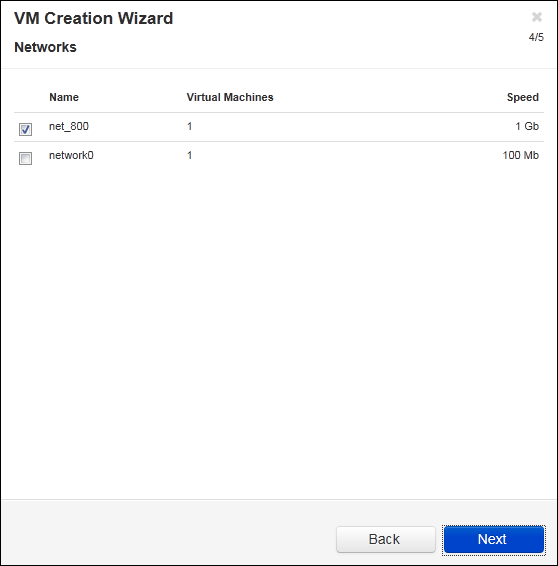
- On the Creation Summary page:
- Review the creation summary. If you need to make changes, click Back.
- If you want to prevent a console session from automatically starting to observe the software installation, deselect Launch Console.
- To accept the VM as provisioned and begin the software installation, click Finish.
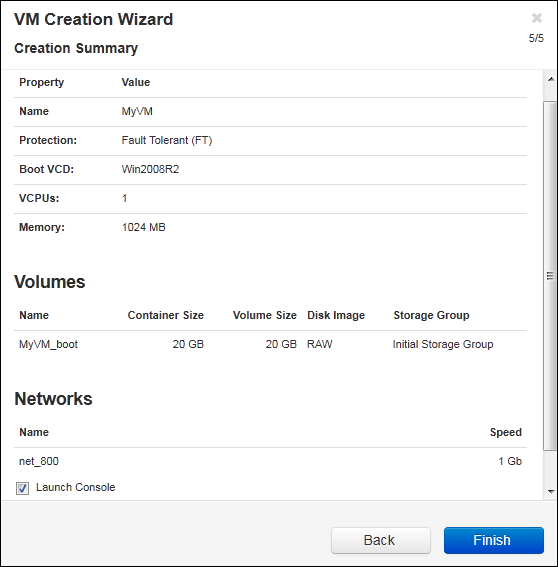
- If applicable, observe the progress of the installation of the operating system and respond to any prompts in the VM console session.
- After you install the operating system, configure the additional resources and software necessary for production use, as described in the Configuring Windows-based Virtual Machines and the Configuring Linux-based Virtual Machines sections of the everRun’s User’s Guide.

NOTE 1:
If the primary PM fails or the VM crashes before the final reboot after the installation process is completed, the installation of the VM may need to be restarted.
NOTE 2:
The VM may not reboot if installations of any of the following are aborted:
a) The guest operating system, including the configuration steps
b) Any middleware or applications that manipulate system files.
For more information on upgrading the everRun software, refer to the Upgrading everRun Software section of the everRun’s User’s Guide.
- Virtual Machines are created and protected with everRun 7.2.
- Connect to the protected Virtual Machine via remote desktop.
- Open a browser in the client machine and start streaming a video.
- While the video is being played, forcibly bring down one of the servers, for example, node0 by pulling the plug.
NOTE: Bring down the server on which the currently active compute instance of the protected Virtual Machine is running so that a transition occurs.
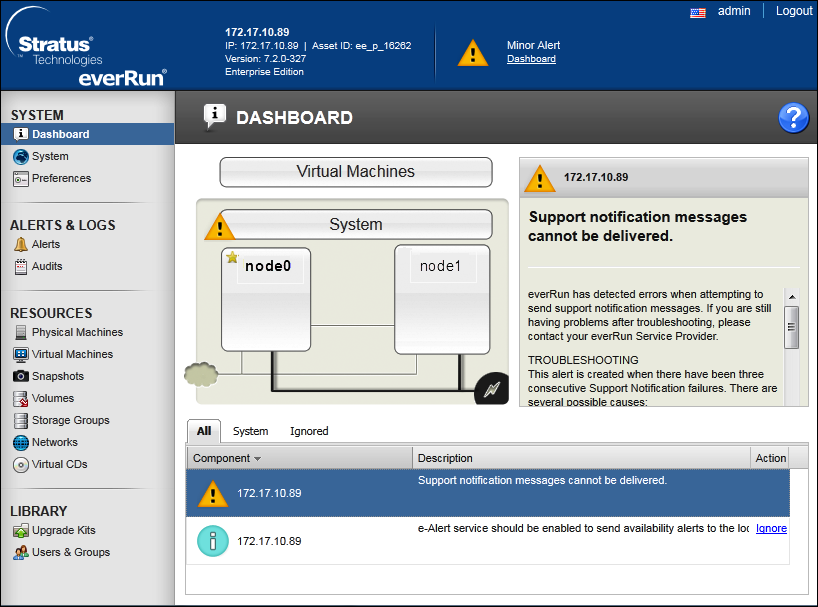
- The remote desktop connection to the protected Virtual Machine is not lost and the video continues to stream. The star icon
 is shifted to node1 making node1 as the primary physical machine.
is shifted to node1 making node1 as the primary physical machine.
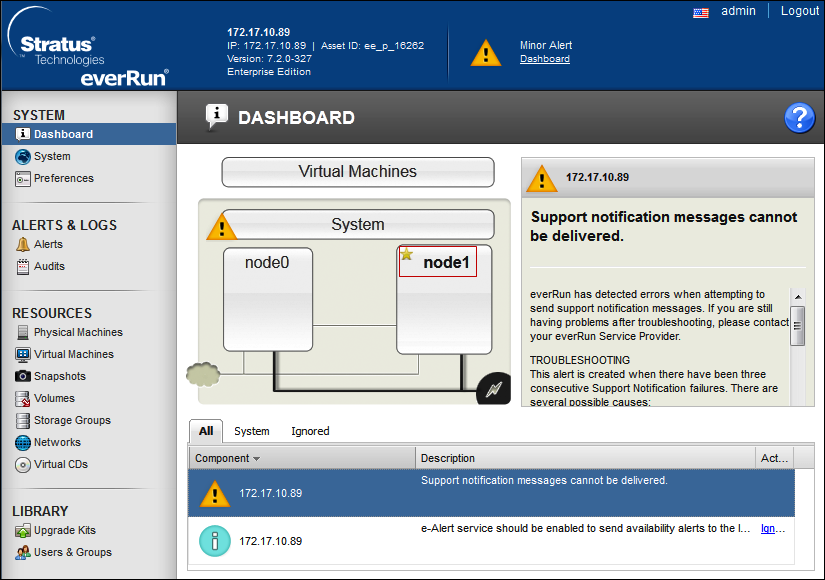
- Select Physical Machines to verify that node1 is the primary physical machine.
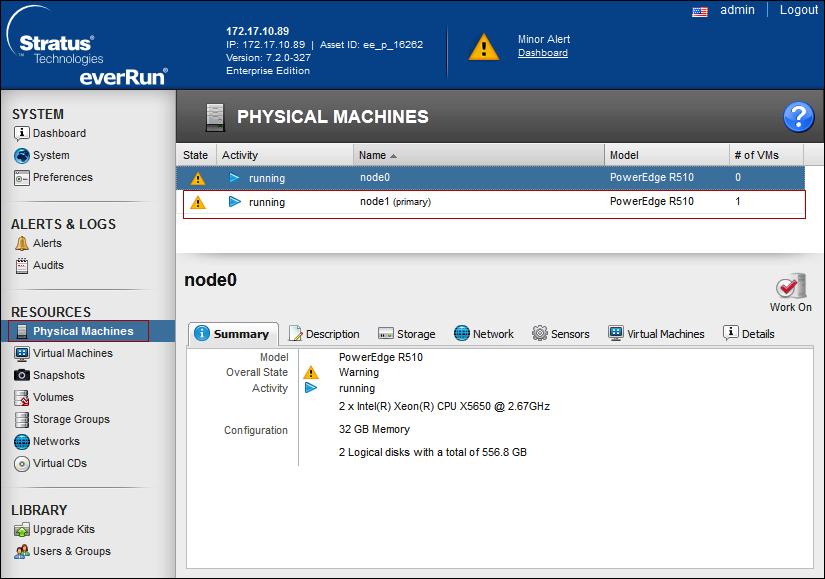
- Virtual Machines are created and protected with everRun 7.2.
- Notification is installed on the client machines.
- Connect a client machine to the protected Virtual Machine via remote desktop.
- Forcibly bring down one of the servers for example, node0 by pulling the plug.
NOTE: Bring down the server on which the currently active compute instance of the protected Virtual Machine is running so that a transition occurs.

- Client does not lose the remote desktop connection to the protected Virtual Machine and all the Notification features are still accessible. The star icon
 is shifted to node1 making node1 as the primary physical machine.
is shifted to node1 making node1 as the primary physical machine.

- Select Physical Machines to verify that node1 is the primary physical machine.

